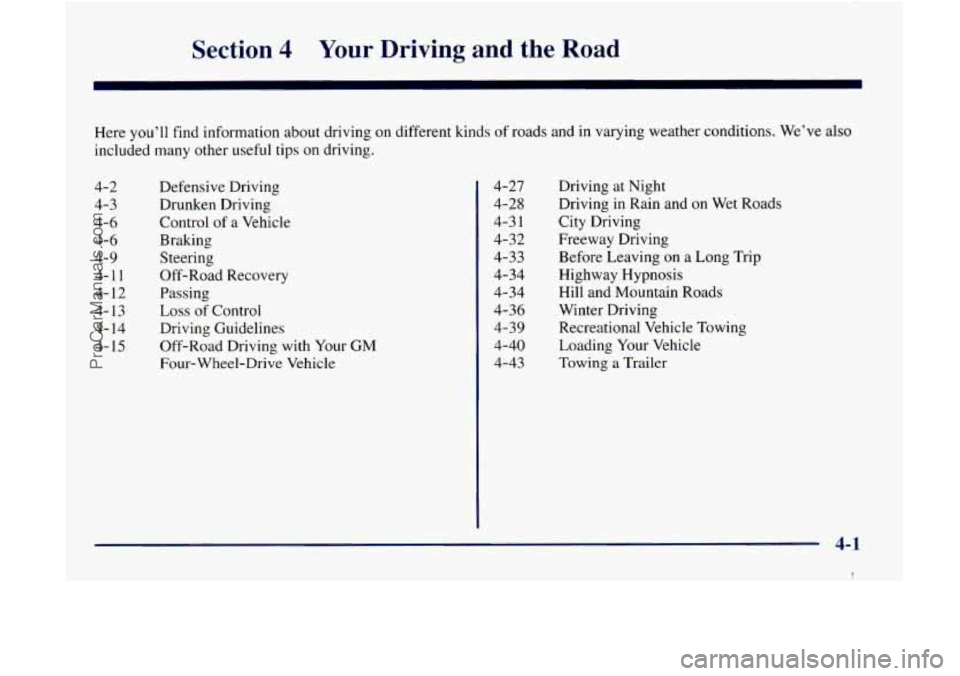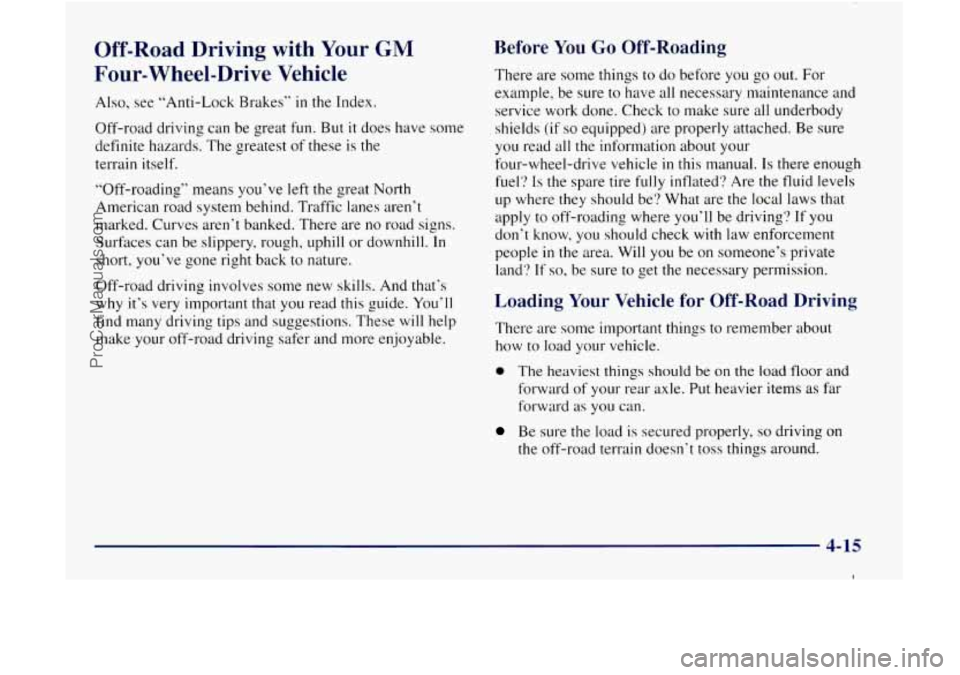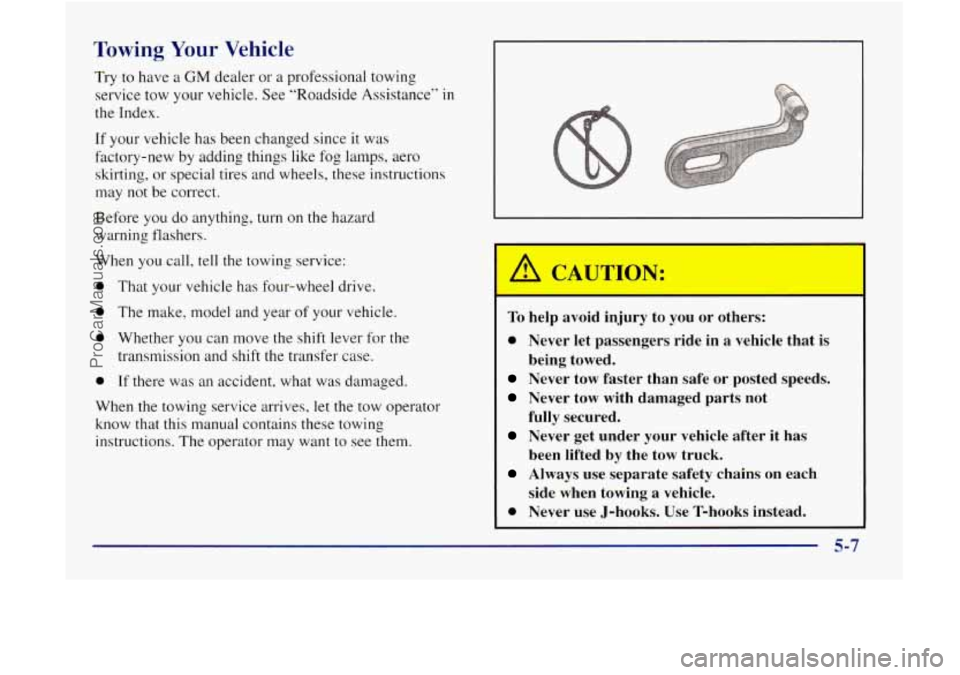1998 GMC ENVOY four wheel drive
[x] Cancel search: four wheel drivePage 4 of 386

About Driving Your Vehicle
As with other vehicles of this type, failure to operate
this vehicle correctly may result in
loss of control or
an accident. Be sure to read the “on-pavement” and
“off-road” driving guidelines in
this manual. (See
“Driving Guidelines” and “Off-Road Driving with
Your Four-Wheel-Drive Vehicle”
in the Index.)
How to Use this Manual
Many people read their owner’s manual from beginning
to end when they first receive their new vehicle. If you
do this, it will help you learn about the features and
controls for your vehicle. In this manual, you’ll find
that pictures and words work together to explain
things quickly.
Index
A good place to look for what you need is the Index in
back of the manual. It’s an alphabetical list of what’s in
the manual, and the page number where you’ll find it.
Safety Warnings and Symbols
You will find a number of safety cautions in this book.
We use a box and the word CAUTION to tell you
about things that could hurt
you if you were to ignore
the warning.
-
These ..lean there is something that could hurt
you
or other people.
In the caution area, we tell you what the hazard is. Then
we tell
you what to do to help avoid or reduce the
hazard. Please read these cautions.
If you don’t, you or
others could be
hurt.
iii
I
ProCarManuals.com
Page 62 of 386

Section 2 Features and Controls
Here you can learn about the many standard and optional features on your vehicle, \
and information on starting,
shifting and braking. Also explained
are the instrument panel and the warning systems that tell you if everything is
working properly
-- and what to do if you have a problem.
2-2 2-4
2-6
2-9 2-10 2-1 1
2-12
2- 13
2- 14
2- 15
2- 16
2-18 2-20
2-2
1
2-23 2-24
2-24
2-25 Keys
Door Locks
Keyless Entry System
LiftgateLiftglass
Theft Content Theft-Deterrent
Passlock@ New Vehicle “Break-In’’
Ignition Positions Starting Your Engine
Engine Coolant Heater
(If Equipped)
Automatic Transmission Operation
Parking Brake Shifting Into PARK (P)
Shifting Out of PARK
(P)
Parking Over Things That Burn
Engine Exhaust Running Your Engine While You’re Parked 2-26
2-26
2-28 2-29
2-30
2-30 2-36
2-39
2-40
2-42
2-49 2-50
2-52 2-52
2-53 2-58 2-60
2-62 Locking Rear Axle
Four-wheel Drive
Windows Horn
Tilt Wheel Turn SignalMultifunction Lever
Exterior Lamps
Interior Lamps
Mirrors Storage Compartments
Ashtrays and Cigarette Lighter
Sun Visors
Accessory Power Outlets Sunroof (If Equipped)
Universal Transmitter Instrument Panel
Instrument Panel Cluster
Warning Lights, Gages and Indicators
2-1
ProCarManuals.com
Page 87 of 386

Locking Rear Axle
Your locking rear axle can give you additional traction
on snow, mud, ice, sand or gravel.
It works like a
standard axle most
of the time, but when one of the rear
wheels has no traction and the other does, this feature
will allow the wheel with traction to move the vehicle.
Four-wheel Drive
Because your vehicle has four-wheel drive, you can
send your engine’s driving power to all four wheels for
extra traction.
To shift out of two-wheel drive and into
four-wheel drive, push the
4HI or 4LO button on the
transfer case switch. You should use
2HI for most
normal driving conditions.
Driving in the 4HI or 4LO positions for a long
time on dry
or wet pavement could shorten the
life
of your vehicle’s drivetrain.
Electronic Transfer Case
The transfer case switches
are above the radio controls.
Use
these switches to shift into and out of four-wheel
drive.
You can choose among three driving settings:
2HI: This setting is for driving in most street and
highway situations. Your front axle is not engaged in
two-wheel drive.
4HI: This setting engages your front axle to help drive
your vehicle. Use
4HI when you need extra traction,
such as on snowy or icy roads, or in most
off-road situations.
2-26
ProCarManuals.com
Page 160 of 386

Section 4 Your Driving and the Road
Here you’ll find information about driving on different kinds of roads and in varying weather conditions, We’ve also
included many other useful tips on driving.
4- 2
4-3
4-6
4-6
4-9
4-11
4-
12
4-13
4- 14
4-15
Defensive Driving
Drunken Driving
Control of
a Vehicle
Braking Steering
Off-Road Recovery
Passing
Loss
of Control
Driving Guidelines
Off-Road Driving with Your GM
Four-Wheel-Drive Vehicle
4-27
4-28
4-3
1
4-32
4-33
4-34
4-34
4-36
4-39
4-40
4-43
Driving at Night
Driving in Rain and on Wet Roads
City Driving
Freeway Driving
Before Leaving on
a Long Trip
Highway Hypnosis
Hill and Mountain Roads
Winter Driving
Recreational Vehicle Towing
Loading Your Vehicle
Towing a Trailer
4- 1
I
ProCarManuals.com
Page 168 of 386

Re,member: Anti-lock doesn’t change the time you need
to get your foot up to the brake pedal or always decrease
stopping distance.
If you get too close to the vehicle in
front of you, you won’t have time to apply your brakes
if that vehicle suddenly slows or stops. Always leave
enough room up ahead
to stop, even though you have
anti-lock brakes.
Steering
Power Steering
If you lose power steering assist because the engine
stops or the system is not functioning, you can steer but
it will take much more effort.
Using Anti-Lock
Don‘t pump the brakes. Just hold the brake pedal down
firmly and let anti-lock work for you. You may feel the
brakes vibrate,
or YOLI may notice some noise, but
this is normal. Your anti-lock brakes work at all
times
-- whether you are in two-wheel or
four-wheel drive.
Braking in Emergencies
With anti-lock, you can steer and brake at the same
time.
In many emergencies, steering can help you more
than even the very best braking.
Steering Tips
Driving on Curves
It’s important to take curves at a reasonable speed.
A lot of the “driver lost control“ accidents mentioned on
the news happen on curves. Here’s
why:
Experienced driver or beginner, each of us is subject to
the same laws of physics when driving on curves. The
traction of the tires against the road surface makes
it
possible for the vehicle to change its path when you turn
the front wheels. If there’s no traction, inertia will keep
the vehicle going
in the same direction. If you’ve ever
tried to steer a vehicle on wet ice, you’ll understand this.
4-9
1
ProCarManuals.com
Page 174 of 386

Off-Road Driving with Your GM
Four-Wheel-Drive Vehicle
Also, see "Anti-Lock Brakes" in the Index.
Off-road driving can be great fun. But
it does have some
definite hazards. The greatest of these is the
terrain itself.
"Off-roading" means you've left the great North
American road system behind. Traffic lanes aren't
marked. Curves aren't banked. There are no road signs.
Surfaces can be slippery, rough,
uphill or downhill. In
short, you've gone right back to nature.
Off-road driving involves some new skills. And that's
why it's very important that
you read this guide. You'll
find many driving tips and suggestions. These will help
make
your off-road driving safer and more enjoyable.
Before You Go Off-Roading
There are some things to do before you go out. For
example, be sure to have all necessary maintenance and
service work done. Check to make sure all underbody
shields
(if so equipped) are properly attached. Be sure
you read all the information about your
four-wheel-drive vehicle
in this manual. Is there enough
fuel? Is the spare tire fully inflated'? Are the fluid levels
up where they should be? What are the local
laws that
apply to off-roading where you'll be driving?
If you
don't know, you should check with
law enforcement
people
in the area. Will you be on someone's private
land'?
If so. be sure to get the necessary permission.
Loading Your Vehicle for Off-Road Driving
There are some important things to remember about
how to load your vehicle.
0 The heaviest things should be on the load floor and
forward of
your rear axle. Put heavier items as far
forward as you can.
Be sure the load is secured properly, so driving on
the off-road terrain doesn't toss things around.
4-15
I
ProCarManuals.com
Page 218 of 386

Towing Your Vehicle
Try to have a GM dealer or a proressional towing
service tow your vehicle. See "Roadside Assistance"
in
the Index.
If your vehicle has been changed since it was
factory-new by adding things like fog lamps, aero
skirting, or special tires and wheels, these instructions
may not be correct.
Before you do anything, turn
on the hazard
warning flashers.
When you call,
tell the towing service:
0 That your vehicle has four-wheel drive.
0 The make, model and year of your vehicle.
0 Whether you can rnolle the shift lever for the
transmission and shift the transfer case.
0 If there was an accident, what was damaged.
When the towing service arrives,
let the tow operator
know that this manual contains these towing
instructions. The operator may want to see them.
To help avoid injury to you or others:
0 Never let passengers ride in a vehicle that is
Never tow faster than safe or posted speeds.
Never tow with damaged parts not
Never get under your vehicle after it has
Always use separate safety chains on each
0 Never use J-hooks. Use T-hooks instead.
being
towed.
fully secured.
been lifted by the tow truck.
side when towing
a vehicle.
5-7
ProCarManuals.com
Page 248 of 386

Section 6 Service and Appearance Care
Here you will find information about the care of your vehicle. This section begins with service and fuel information,
and then
it shows how to check important fluid and lubricant levels. There is also technical information about your
vehicle, and a part devoted
to its appearance care.
6-2
6-3
6-5
6-5
6-7
6-8
6-
10
6-14
6- 15
6-19
6-20
6-2
1
6- 24
6-25
6-25
6-26
6-
2’7
Service
Fuel
Fuels in Foreign Countries
Filling Your Tank
Filling a Portable
Fuel Container
Checking Things Under the Hood
Engine Oil
Air Cleaner
Automatic Transmission Fluid
Rear Axle
Four- Wheel Drive
Engine Coolant
Radiator Pressure Cap
Thermostat
Power Steering Fluid
Windshield Washer Fluid
Brakes Battery
Bulb Replacement
Windshield Wiper Blade Replacement
Tires
Appearance Care
Cleaning the Inside
of Your Vehicle
Care of Safety Belts
Cleaning the Outside of Your Vehicle
Appearance Care Materials Chart
Vehicle Identification Number (VIN)
Service Parts Identification Label
Electrical System
Replacement Bulbs
Capacities and Specifications
Air Conditioning Refrigerants
6-30
6-3
1
6-34
6-36
6-45
6-46
6-48
6-50
6-53
6-54
6-54
6-54
6- 60
6- 60
6-62
6-1
ProCarManuals.com